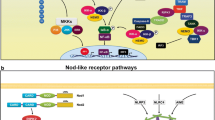Abstract
When taking their blood meal on the mammalian host, ticks transfer a multitude of different proteins from their saliva into the host. Some of these proteins are hijacked by pathogens for their own purposes. Borrelia burgdorferi, the Lyme disease agent, is critically dependent on the presence of the tick protein Salp15 when infecting the host. Similarly, Anaplasma phagocytophilum, which causes anaplasmosis, needs Salp16, a homologue of Salp15, to get transferred from the host into the tick. Here we analyzed whether adaptive evolution has shaped the Salp15 protein family. Using site-specific estimates of KA/KS ratios, we identified different positions within the Salp15 protein family which have undergone a phase of positive selection. Additionally, we analyzed the B. burgdorferi protein interacting with Salp15, OspC. Again, sites showing signs of positive selection were identified, although they are more likely a result of the antigenic features of OspC than of the influence of Salp15. The identification of probably functionally relevant sites in the Salp15 family might direct the detailed experimental analysis of their interaction with human and bacterial proteins.


Similar content being viewed by others
References
Altschul SF, Madden TL, Schaffer AA, Zhang J, Zhang Z, Miller W, Lipman DJ (1997) Gapped BLAST and PSI-BLAST: a new generation of protein database search programs. Nucleic Acids Res 25:3389–3402
Anguita J, Ramamoorthi N, Hovius JW, Das S, Thomas V, Persinski R, Conze D, Askenase PW, Rincon M, Kantor FS, Fikrig E (2002) Salp15, an Ixodes scapularis salivary protein, inhibits CD4(+) T cell activation. Immunity 16:849–859
Castresana J (2000) Selection of conserved blocks from multiple alignments for their use in phylogenetic analysis. Mol Biol Evol 17:540–552
Das S, Banerjee G, DePonte K, Marcantonio N, Kantor FS, Fikrig E (2001) Salp25D, an Ixodes scapularis antioxidant, is 1 of 14 immunodominant antigens in engorged tick salivary glands. J Infect Dis 184:1056–1064
Earnhart CG, Marconi RT (2007) OspC phylogenetic analyses support the feasibility of a broadly protective polyvalent chimeric Lyme disease vaccine. Clin Vaccine Immunol 14:628–634
Edgar RC (2004) MUSCLE: a multiple sequence alignment method with reduced time and space complexity. BMC Bioinformatics 5:113
Eicken C, Sharma V, Klabunde T, Owens RT, Pikas DS, Hook M, Sacchettini JC (2001) Crystal structure of Lyme disease antigen outer surface protein C from Borrelia burgdorferi. J Biol Chem 276:10010–10015
Felsenstein J (2005) PHYLIP (Phylogeny Inference Package) version 3.6. Distributed by the author. Department of Genome Sciences, University of Washington, Seattle
Foley J, Nieto N (2007) Anaplasma phagocytophilum subverts tick salivary gland proteins. Trends Parasitol 23:3–5
Garg R, Juncadella IJ, Ramamoorthi N, Ashish, Ananthanarayanan SK, Thomas V, Rincon M, Krueger JK, Fikrig E, Yengo CM, Anguita J (2006) Cutting edge: CD4 is the receptor for the tick saliva immunosuppressor, salp15. J Immunol 177:6579–6583
Gillespie RD, Mbow ML, Titus RG (2000) The immunomodulatory factors of bloodfeeding arthropod saliva. Parasite Immunol 22:319–331
Hill CA, Wikel SK (2005) The Ixodes scapularis Genome Project: an opportunity for advancing tick research. Trends Parasitol 21:151–153
Hovius JW, de Jong MA, den Dunnen J, Litjens M, Fikrig E, van der Poll T, Gringhuis SI, Geijtenbeek TB (2008) Salp15 binding to DC-SIGN inhibits cytokine expression by impairing both nucleosome remodeling and mRNA stabilization. PLoS Pathog 4:e31
Motameni AR, Juncadella IJ, Ananthanarayanan SK, Hedrick MN, Huet-Hudson Y, Anguita J (2004) Delivery of the immunosuppressive antigen Salp15 to antigen-presenting cells by Salmonella enterica serovar Typhimurium aroA mutants. Infect Immun 72:3638–3642
Nielsen R, Yang Z (1998) Likelihood models for detecting positively selected amino acid sites and applications to the HIV-1 envelope gene. Genetics 148:929–936
Ribeiro JM, Arca B, Lombardo F, Calvo E, Phan VM, Chandra PK, Wikel SK (2007) An annotated catalogue of salivary gland transcripts in the adult female mosquito, Aedes aegypti. BMC Genomics 8:6
Schuijt TJ, Hovius JW, van Burgel ND, Ramamoorthi N, Fikrig E, van Dam AP (2008) The tick salivary protein Salp15 inhibits the killing of serum-sensitive Borrelia burgdorferi sensu lato isolates. Infect Immun 76:2888–2894
Suyama M, Torrents D, Bork P (2006) PAL2NAL: robust conversion of protein sequence alignments into the corresponding codon alignments. Nucleic Acids Res 34:W609–W612
Swanson WJ, Nielsen R, Yang Q (2003) Pervasive adaptive evolution in mammalian fertilization proteins. Mol Biol Evol 20:18–20
Theisen M, Borre M, Mathiesen MJ, Mikkelsen B, Lebech AM, Hansen K (1995) Evolution of the Borrelia burgdorferi outer surface protein OspC. J Bacteriol 177:3036–3044
Trager W (1939) Acquired immunity to ticks. J Parasitol 25:57–81
Valenzuela JG, Charlab R, Mather TN, Ribeiro JM (2000) Purification, cloning, and expression of a novel salivary anticomplement protein from the tick, Ixodes scapularis. J Biol Chem 275:18717–18723
Wong WS, Yang Z, Goldman N, Nielsen R (2004) Accuracy and power of statistical methods for detecting adaptive evolution in protein coding sequences and for identifying positively selected sites. Genetics 168:1041–1051
Yang Z (1997) PAML: a program package for phylogenetic analysis by maximum likelihood. Comput Appl Biosci 13:555–556
Yang Z (1998) Likelihood ratio tests for detecting positive selection and applic ation to primate lysozyme evolution. Mol Biol Evol 15:568–573
Author information
Authors and Affiliations
Corresponding author
Electronic supplementary material
Below is the link to the electronic supplementary material
Rights and permissions
About this article
Cite this article
Schwalie, P.C., Schultz, J. Positive Selection in Tick Saliva Proteins of the Salp15 Family. J Mol Evol 68, 186–191 (2009). https://doi.org/10.1007/s00239-008-9194-1
Received:
Revised:
Accepted:
Published:
Issue Date:
DOI: https://doi.org/10.1007/s00239-008-9194-1




